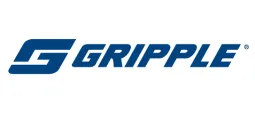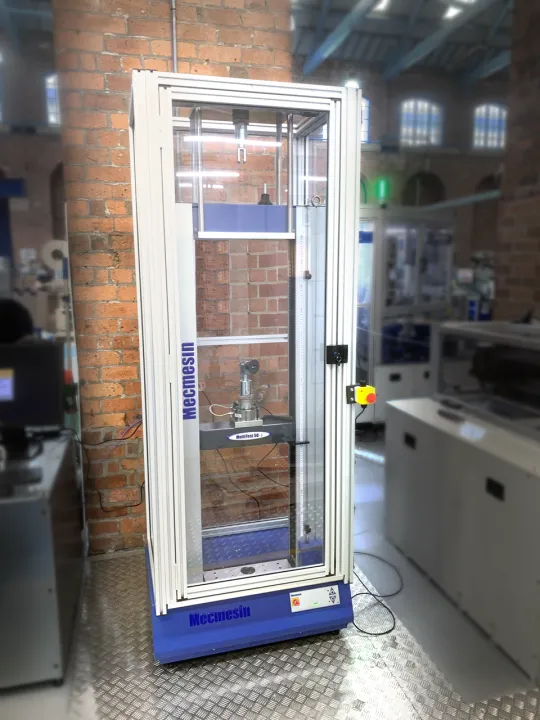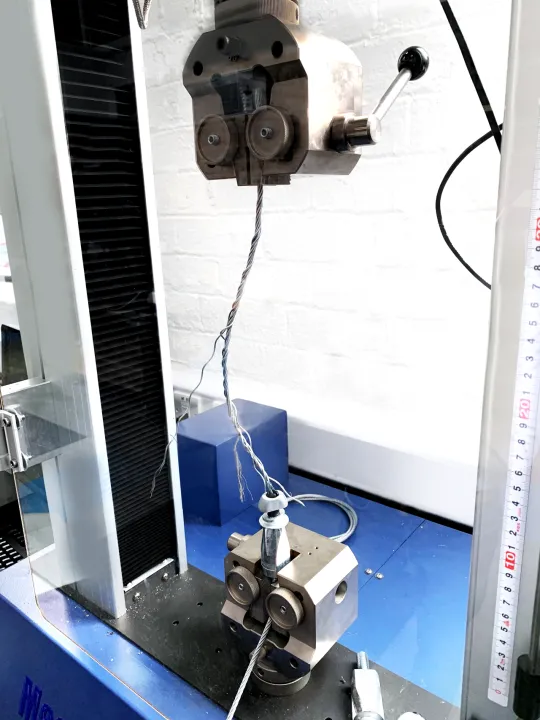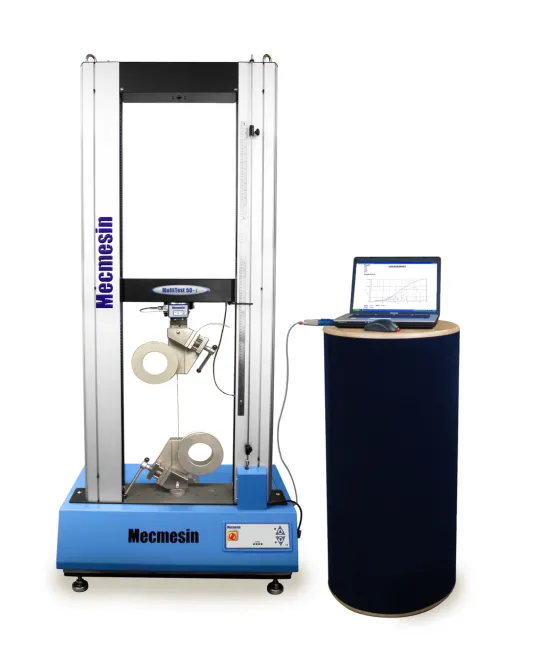
Tensile testing wire joining systems


Highlights
Solution
- Universal Testing Machine 50 kN
- Grips adapted to hold wire, joiners and tensioners
Benefits
- No need to outsource testing - flexibility of the software allows rapid testing of the proof-load of various components and finished products
- Time-saving - Interchangeable grips require minimal set-up and securely hold slippery metal surfaces
Prior to Mecmesin we would have tied the wire rope in a choke knot to perform the test, but now with the rope grips we are able to test more accurately the performance of the wire rope.
Thomas Reynolds, Testing Manager
Gripple Ltd.
Requirement
Gripple design and manufacture wire joiners and tensioners used extensively in the Building Services, Agriculture, Civil Engineering, Viticulture and Seismic Construction sectors. The company originated through innovation in the field of fasteners for wires—which “grip” and “pull”—and these components feature in award-winning solutions for clamping, seismic bracing, suspension and hanging systems.
As an alternative to traditional threaded rods and channel they feature in applications as diverse as suspending pipework and HVAC systems in office buildings through to anchoring miles of wire trellis used to support the vines for wine-growers.
Gripple's quality policy implements checks at every stage of manufacture to ensure that products delivered to the end customer are consistently of the highest quality.
As part of the continuous improvement ethic, the Quality and Design Department wanted to review their in-house methods and re-evaluate the test procedures for measuring break loads in their cable components. Gripple’s wire rope fastening systems are engineered to achieve a minimum load rating which, if exceeded, creates a break in the wire rope as the failure mode. A 5:1 safe working load (SWL) safety factor is adhered to and the test system must cater for wire specimens in the range of 1.5—6 mm diameter.
Making sure that Gripple products and components are proven to easily withstand the loads they will encounter when installed, is the job of a tensile tester
Solution
Mecmesin developed a solution for Gripple which was based around the MultiTest 50-i Universal Testing Machine. It’s tried-and-tested Emperor software platform delivered the flexibility required for testing to various in-house methods. From measuring the ultimate tensile strength of wire strands and cores, testing the pull strength of joiners and end-fixings right through to testing the performance of a dedicated seismic restraint device, the Mecmesin 50kN capacity test system proved an ideal choice.
The MultiTest 50-i twin-column tensile tester was supplied with lever-action wedge grips and specialist capstan rope grips; all rated to 50 kN. Previous test procedures had secured the test specimen to the fixture by means of a choke knot, which had proved generally effective. However, with some configurations of wire gauge it had become the point of failure. In order to remove this variability, back-to-back comparison tests were performed with combinations of the available grips:
Two wedge grips; upper wedge grip clamped the bale, lower wedge grip held the choke knot.
A hybrid set-up; capstan rope grip as the upper grip, lower wedge grip held the choke knot.
Two capstan rope grips; upper and lower grips secured both the bale and choke knot.
Round-robin tests using these grip combinations were performed on each wire size at a constant rate of extension of 100 mm/min, running until the Emperor software detected a break. The peak force was recorded and the specimen checked to ensure that the failure was not attributable to local stresses at the grip, slippage inside the grips or any other invalid failure mode.
Configuration 3, comprising the pair of specifically-designed capstan rope grips, performed consistently across all specimens, returning accurate and repeatable results; thus meeting the high standards set by Gripple.
The company understood the importance not only of the choice of correct testing equipment, but also the best way in which to configure and implement a system. This proved essential in creating the optimum internal test procedures to guarantee thorough QC for its own customers.
Additional testing requirements for checking the tensile strength of seismic restraints to ANSI 171-2017 were met by easily creating a test routine in Emperor software and fitting a pair of wedge grips to the tester.
To accommodate longer eye-loop fixings it was necessary to adapt a MultiTest 50-i tensile tester so that there was enough space to fit the longer specimens and the grips. By building a surround-cage and modifying the moving crosshead of the tester, Mecmesin successfully developed an affordable test system to meet these unusual challenges. A full-length interlocked safety guard to shield the operator during testing, put the finishing touch to this customised test system.
As Gripple UK also needed to deploy test equipment in their global manufacturing locations in France, India and Poland, the Mecmesin system provided flexible software licensing for easy exchange of test programs and test results. This ensured exactly the same test routines and best practice standards could be efficiently shared amongst all sites, making data comparison seamless.
Test equipment
- MultiTest 50-i twin column tensile tester
- ILC-P 50 kN intelligent loadcell
- Capstan Rope Grips and Lever-action Wedge Grips
- Emperorᵀᴹ fully programmable force testing software















